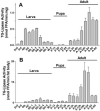Mobilization of lipid stores in Manduca sexta: cDNA cloning and developmental expression of fat body triglyceride lipase, TGL
- PMID: 20060045
- PMCID: PMC2829384
- DOI: 10.1016/j.ibmb.2009.12.008
Mobilization of lipid stores in Manduca sexta: cDNA cloning and developmental expression of fat body triglyceride lipase, TGL
Abstract
Fatty acids stored as triglycerides (TG) in the fat body serve as precursor in multiple processes including energy production and synthesis of cellular components. Mobilization of fatty acids from TG depends on the action of lipases. The fat body triglyceride lipase from Manduca sexta, MsTGL, is the only insect lipase that has been purified and characterized, so far. A TGL cDNA from M. sexta fat body encoding a 649 amino acid protein was cloned and its identity confirmed by mass spectrometry and Edman sequencing data of the purified protein. The protein sequence has conserved domains and residues of potential importance for the function and regulation of TGL activity. The expression of TGL and the lipase activity of fat body homogenates were studied in several developmental stages of M. sexta. TG-hydrolase activity of fat body increased as larva grew to the last instar and, then, decreased to minimal levels during pupa stage. Lipase activity was progressively restored in adult insects and reached maximum values at this stage. The fat body lipase activity from adult insects, 1-2 day after emergence, was 9-fold higher than that from 2 to 3 days old 5th-instar larvae. A good correlation was found between the abundance of TGL protein and the lipase activity of fat body homogenates. This correlation and the expression pattern of TGL throughout development are consistent with the notion that TGL is the main fat body TG lipase of M. sexta.
2010 Elsevier Ltd. All rights reserved.
Figures






References
-
- Aravind L. The WWE domain: a common interaction module in protein ubiquitination and ADP ribosylation. Trends Biochem Sci. 2001;26:273–5. - PubMed
-
- Arrese EL, Flowers MT, Gazard JL, Wells MA. Calcium and cAMP are second messengers in the adipokinetic hormone-induced lipolysis of triacylglycerols in Manduca sexta fat body. J Lipid Res. 1999;40:556–64. - PubMed
-
- Arrese EL, Patel RT, Soulages JL. The main triglyceride-lipase from the insect fat body is an active phospholipase A(1): identification and characterization. J Lipid Res. 2006;47:2656–67. - PubMed
Publication types
MeSH terms
Substances
Grants and funding
LinkOut - more resources
Full Text Sources
Other Literature Sources
Miscellaneous

